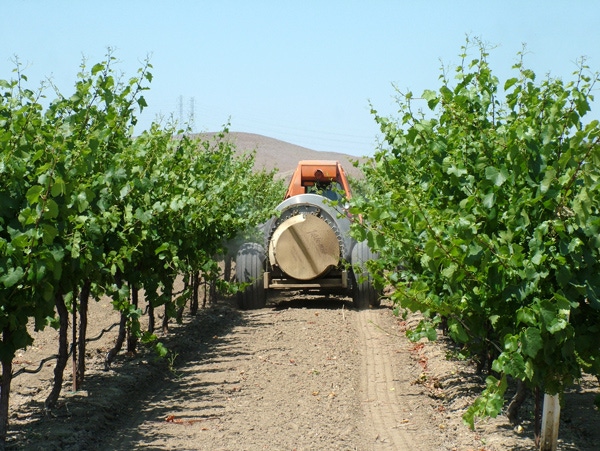
Botrytis bunch rot can appear early in the season as shoot blight following frequent spring rains. Flowers can become infected with the pathogen, Botrytis cinerea, during bloom. Usually this fungus becomes dormant until late in the season when sugar concentration increases in the infected berry. The fungus then resumes growth and spreads throughout the berry.
As described in the University of California Pest Management Guidelines for grapes, infected berries split and leak. This allows the pathogen to grow and sporulate on berry surfaces and spread to adjoining berries by mid-season. Spores from infected fruit can directly infect intact, ripe berries as harvest approaches.
The fungus overwinters as sclerotia in berry mummies on the ground or left hanging on the vine and in canes. Germination and spore production occur in spring. Infections require free water for a definite period of time depending on temperature.
Rain during bloom can trigger infections, Preclose rachis infections often occur on Chardonnay.
Late-season infections are most severe when relative humidity exceeds 92 percent; free moisture is present on the fruit surface; and temperatures are in the 58° to 82°F range.
Because the juice in the berry can provide the water and nutrients needed for fungal growth, berries damaged by insects, birds and machinery may become infected at any time after the fruit begins to ripen.
Success in managing Botrytis bunch rot hinges, in part, on achieving good spray coverage, which is affected by the canopy and stage of growth. Also, it requires the use of resistant varieties and various cultural practices.
UC IPM specialists report that canopy management and leaf removal, in particular, can produce excellent control. Removing basal leaves or basal lateral shoots at or immediately after berry set has resulted in significantly reduced incidence and severity of disease, they add.
However, in warmer growing areas, removing too many leaves can lead to sunburned fruit, they caution. Removing leaves later in the season makes this condition worse. But, removing leaves at cluster set allows the berries to acclimate readily to sunlight and develop a thick cuticle that helps prevent sunburn as well as Botrytis infection.
On cordon-trained vines, the UC IPM specialists recommend removing leaves only from the side of the vine that receives morning sun. Do not remove lateral shoots. If leaves are not removed and weather is dry in spring, one fungicide application should be made sometime between bloom and pea-size berries. Otherwise, apply sprays before rainfall, especially at bloom or after veraison.
For northern and coastal production areas, the UC IPM guidelines call for removing leaves or lateral shoots around clusters beginning at late bloom and continuing to berry set. In the Central Valley remove leaves between bloom and berry set or hedge in mid-season to open the canopy.
Organically-acceptable control methods include canopy management and other cultural control methods along with sprays of Organic JMS Stylet Oil and Serenade.
The UC IPM specialists offer these tips for monitoring and treating for Botrytis bunch rot:
Look for flagging shoot tips or entire shoots during rapid shoot growth. If you see flagging, try to break or cut the shoot in the region between the flaccid area and the adjacent area with normal turgor. Brown discoloration on the cut surface is evidence of Botrytis.
If the entire shoot is involved, look for a hole at the base, which could indicate feeding by branch and twig borer.
If basal leaves are not removed, apply fungicides before rain in northern and coastal production areas to prevent flower infections.
Research data shows a trend toward better control if fungicides are applied at bloom, preclose and veraison. With proper leaf removal, sprays can be limited to one application if wet weather occurs during bloom (or none if no rain occurs). Thorough coverage is essential for all fungicide treatments.
A fungicide application may also be warranted if a major rain is expected late in the season when grapes are nearly mature. Otherwise, management of Botrytis bunch rot following bloom generally relies on proper cultural practices.
More information on flagging symptoms of this disease, fruit damage at harvest and fungicide choices is available at www.ipm.ucdavis.edu.
About the Author(s)
You May Also Like




